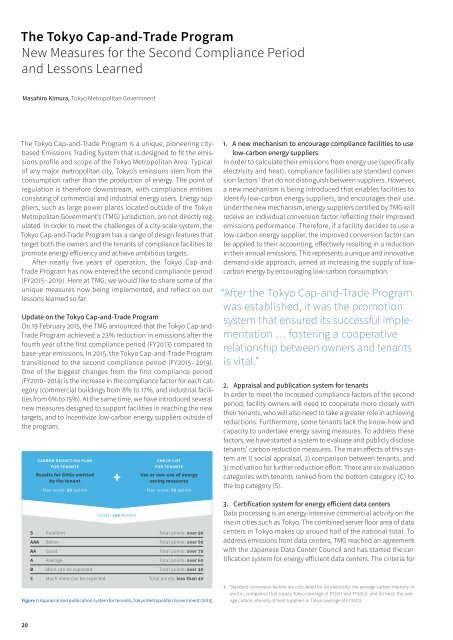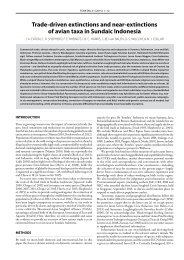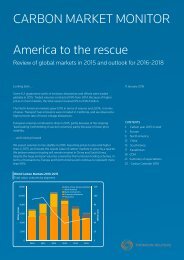Emissions Trading Worldwide
1TbjEHd
1TbjEHd
You also want an ePaper? Increase the reach of your titles
YUMPU automatically turns print PDFs into web optimized ePapers that Google loves.
The Tokyo Cap-and-Trade Program<br />
New Measures for the Second Compliance Period<br />
and Lessons Learned<br />
Masahiro Kimura, Tokyo Metropolitan Government<br />
The Tokyo Cap-and-Trade Program is a unique, pioneering citybased<br />
<strong>Emissions</strong> <strong>Trading</strong> System that is designed to fit the emissions<br />
profile and scope of the Tokyo Metropolitan Area. Typical<br />
of any major metropolitan city, Tokyo’s emissions stem from the<br />
consumption rather than the production of energy. The point of<br />
regulation is therefore downstream, with compliance entities<br />
consisting of commercial and industrial energy users. Energy suppliers,<br />
such as large power plants located outside of the Tokyo<br />
Metropolitan Government’s (TMG) jurisdiction, are not directly regulated.<br />
In order to meet the challenges of a city-scale system, the<br />
Tokyo Cap-and-Trade Program has a range of design features that<br />
target both the owners and the tenants of compliance facilities to<br />
promote energy efficiency and achieve ambitious targets.<br />
After nearly five years of operation, the Tokyo Cap-and-<br />
Trade Program has now entered the second compliance period<br />
(FY2015 – 2019). Here at TMG, we would like to share some of the<br />
unique measures now being implemented, and reflect on our<br />
lessons learned so far.<br />
Update on the Tokyo Cap-and-Trade Program<br />
On 19 February 2015, the TMG announced that the Tokyo Cap-and-<br />
Trade Program achieved a 23% reduction in emissions after the<br />
fourth year of the first compliance period (FY2013) compared to<br />
base-year emissions. In 2015, the Tokyo Cap-and-Trade Program<br />
transitioned to the second compliance period (FY2015 – 2019).<br />
One of the biggest changes from the first compliance period<br />
(FY2010 – 2014) is the increase in the compliance factor for each category<br />
(commercial buildings from 8% to 17%, and industrial facilities<br />
from 6% to 15%). At the same time, we have introduced several<br />
new measures designed to support facilities in reaching the new<br />
targets, and to incentivize low-carbon energy suppliers outside of<br />
the program.<br />
carbon reduction plan<br />
for tenants<br />
Results for GHGs emitted<br />
by the tenant<br />
Max score: 30 points<br />
S<br />
AAA<br />
AA<br />
A<br />
B<br />
C<br />
+<br />
total: 100 points<br />
check list<br />
for tenants<br />
Use or non-use of energy<br />
saving measures<br />
Max score: 70 points<br />
Excellent Total points: over 90<br />
Better Total points: over 80<br />
Good Total points: over 70<br />
Average Total points: over 60<br />
More can be expected Total points: over 40<br />
Much more can be expected Total points: less than 40<br />
Figure 1: Appraisal and publication system for tenants, Tokyo Metropolitan Government (2015)<br />
1. A new mechanism to encourage compliance facilities to use<br />
low-carbon energy suppliers<br />
In order to calculate their emissions from energy use (specifically<br />
electricity and heat), compliance facilities use standard conversion<br />
factors 1 that do not distinguish between suppliers. However,<br />
a new mechanism is being introduced that enables facilities to<br />
identify low-carbon energy suppliers, and encourages their use.<br />
Under the new mechanism, energy suppliers certified by TMG will<br />
receive an individual conversion factor reflecting their improved<br />
emissions performance. Therefore, if a facility decides to use a<br />
low-carbon energy supplier, the improved conversion factor can<br />
be applied to their accounting, effectively resulting in a reduction<br />
in their annual emissions. This represents a unique and innovative<br />
demand-side approach, aimed at increasing the supply of lowcarbon<br />
energy by encouraging low-carbon consumption.<br />
“After the Tokyo Cap-and-Trade Program<br />
was established, it was the promotion<br />
system that ensured its successful implementation<br />
… fostering a cooperative<br />
relationship between owners and tenants<br />
is vital.”<br />
2. Appraisal and publication system for tenants<br />
In order to meet the increased compliance factors of the second<br />
period, facility owners will need to cooperate more closely with<br />
their tenants, who will also need to take a greater role in achieving<br />
reductions. Furthermore, some tenants lack the know-how and<br />
capacity to undertake energy saving measures. To address these<br />
factors, we have started a system to evaluate and publicly disclose<br />
tenants’ carbon reduction measures. The main effects of this system<br />
are 1) social appraisal, 2) comparison between tenants, and<br />
3) motivation for further reduction effort. There are six evaluation<br />
categories with tenants ranked from the bottom category (C) to<br />
the top category (S).<br />
3. Certification system for energy efficient data centers<br />
Data processing is an energy-intensive commercial activity on the<br />
rise in cities such as Tokyo. The combined server floor area of data<br />
centers in Tokyo makes up around half of the national total. To<br />
address emissions from data centers, TMG reached an agreement<br />
with the Japanese Data Center Council and has started the certification<br />
system for energy efficient data centers. The criteria for<br />
1 Standard conversion factors are calculated for (a) electricity: the average carbon intensity of<br />
electric companies that supply Tokyo (average of FY2011 and FY2012); and (b) heat: the average<br />
carbon intensity of heat suppliers in Tokyo (average of FY2012).<br />
20




